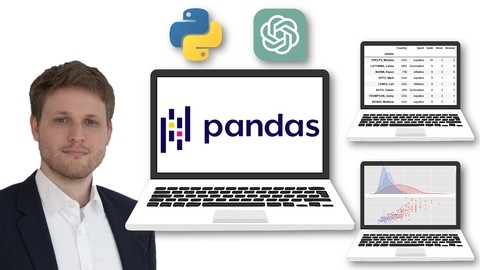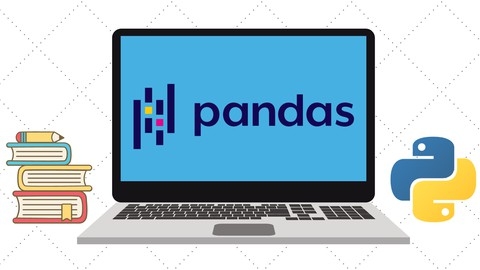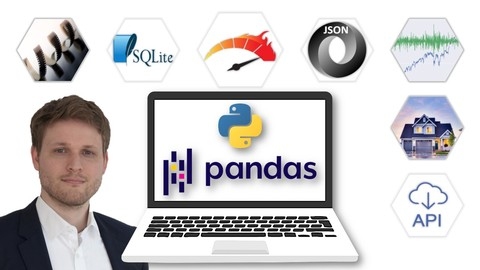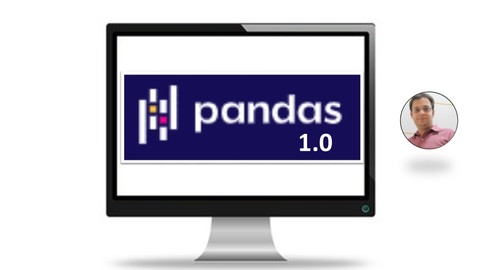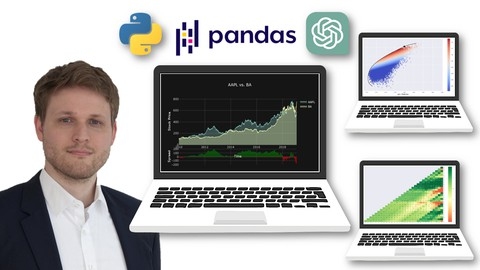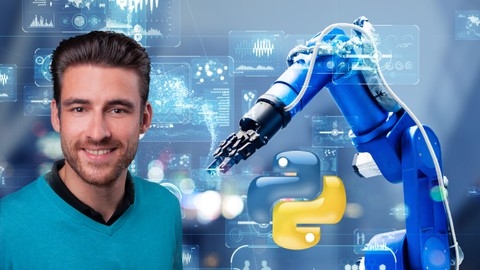Pandas is a powerful Python library that forms the backbone of data analysis and manipulation in Python.
It allows you to work efficiently with tabular data, offering features like data cleaning, transformation, aggregation, and visualization.
By mastering Pandas, you can unlock a world of possibilities in data science, machine learning, and more.
Finding a comprehensive and engaging Pandas course on Udemy can be a daunting task, with so many options available.
You want a course that’s both challenging and accessible, taught by experts, and tailored to your learning style.
For the best Pandas course overall on Udemy, we recommend Data Analysis with Pandas and Python.
This course starts by installing the Anaconda distribution and setting up your coding environment.
Then it guides you through a crash course on Python basics before diving into Pandas.
You’ll learn how to use Jupyter Notebooks, create and manipulate Pandas Series and DataFrames, handle missing data, perform mathematical operations, work with text data, and more.
It’s taught by experienced instructors and includes a wealth of real-world projects and applications, making it a truly practical learning experience.
However, this is just one of many great options for learning Pandas on Udemy.
Whether you’re a complete beginner or have some prior experience, we’ve got you covered.
Keep reading for a comprehensive list of recommended courses, including choices for specific skill levels, learning styles, and career goals.
Data Analysis with Pandas and Python
This comprehensive course covers everything you need to master data analysis using Python’s powerful pandas library.
The syllabus starts by guiding you through installing the Anaconda distribution and setting up your coding environment.
You’ll learn how to use Jupyter Notebooks, an interactive platform for writing and executing Python code.
The course then dives into a crash course on Python basics like data types, variables, functions, lists, and dictionaries.
This ensures you have a solid foundation before moving on to pandas.
You’ll thoroughly explore the pandas Series and DataFrame objects, which are essential for working with structured data.
The syllabus covers creating, filtering, sorting, and manipulating these objects using a wide range of methods and techniques.
You’ll learn how to handle missing data, perform mathematical operations, work with text data, and more.
The course also covers advanced pandas topics like MultiIndexes for handling hierarchical data, GroupBy operations for grouping and aggregating data, and merging/joining multiple datasets.
You’ll learn how to work with dates and times, import/export data from various file formats, and create visualizations like line charts and bar graphs using matplotlib.
Throughout the syllabus, you’ll work with real-world datasets, ensuring you gain practical experience.
The lessons are designed to be clear and concise, with transitions to help the content flow naturally.
You’ll be writing as if speaking directly to the reader, using a conversational yet technical tone.
The Complete Pandas Bootcamp 2024: Data Science with Python
You will start by learning the fundamentals of working with tabular data using DataFrames and Series objects.
The course covers essential skills like importing data from various sources, cleaning and preprocessing data, handling missing values, and performing data manipulation tasks like filtering, sorting, and indexing.
Through hands-on coding exercises and projects, you will gain practical experience in applying these techniques to real-world datasets.
The course also delves into more advanced topics such as merging and joining datasets, grouping and aggregating data, reshaping and pivoting, and creating new features from existing data.
Additionally, you will learn how to use Pandas for time series analysis, a crucial skill for finance and investing applications.
The course covers importing and handling time series data, resampling, and performing financial calculations like returns and risk measures.
Towards the end, the course introduces you to machine learning with Pandas and scikit-learn, covering both regression and classification problems.
You will learn how to prepare data for machine learning models, split datasets into training and testing sets, and evaluate model performance.
The course also includes sections on debugging techniques, using ChatGPT for coding assistance, and an overview of the new features introduced in Pandas version 1.0.
The appendix covers essential Python basics, NumPy, and statistical concepts that underpin data analysis.
The Ultimate Pandas Bootcamp: Advanced Python Data Analysis
You’ll start by learning the fundamentals of pandas Series and DataFrames, the core data structures for storing and manipulating tabular data.
You’ll dive into indexing, selecting, filtering, and transforming data using various methods like loc, iloc, and boolean masks.
The course covers handling missing data, performing descriptive statistics, sorting, and applying arithmetic operations on Series and DataFrames.
As you progress, you’ll learn advanced techniques for working with multiple DataFrames, such as concatenating, merging, and joining datasets.
The course also covers hierarchical indexing with MultiIndexes, enabling you to work with higher-dimensional data efficiently.
You’ll explore the split-apply-combine paradigm using groupby operations, allowing you to perform sophisticated data aggregations and transformations based on group characteristics.
Additionally, you’ll learn how to reshape data using pivoting and unpivoting techniques with pivot and pivot_table.
The course dedicates sections to working with dates and times, including parsing, creating date ranges, resampling time series data, and handling time zones.
You’ll also learn text manipulation techniques using regular expressions and pandas string methods for cleaning and preprocessing text data.
Data visualization is covered using matplotlib, enabling you to create various plots like line graphs, bar charts, histograms, and scatter plots to visually explore your data.
The course also touches on reading and writing data in different formats like JSON, HTML, and Excel.
Throughout the course, you’ll work with real-world datasets, reinforcing your learning with practical examples and skill challenges.
The appendices provide a rapid-fire introduction to Python fundamentals and instructions for local installation and setup.
Data Manipulation in Python: A Pandas Crash Course
The course starts with an introduction to Python and setting up your development environment, ensuring you have the necessary tools to get started.
You will learn how to work with datasets using Jupyter Notebooks and load data into pandas DataFrames.
The course covers the differences between pandas and NumPy, two essential libraries for data manipulation in Python.
You’ll gain hands-on experience creating, saving, and inspecting DataFrames.
Visualisation is a crucial aspect of data analysis, and this course dedicates a section to it.
You will learn how to create basic plots using pandas and matplotlib, visualise 1D and 2D distributions, and style pandas table outputs.
The course even covers higher-dimensional visualisations, ensuring you have a comprehensive understanding of data visualisation techniques.
Data manipulation is a core focus of the course.
You will learn how to perform basic operations like slicing, filtering, replacing, and thresholding data.
The course also covers applying functions, mapping, and vectorised operations on DataFrames.
Grouping and merging data are essential skills for any data analyst, and this course covers them in-depth.
You will learn how to group data, perform intelligent imputation, and aggregate grouped data.
The merging section covers different types of merging, helpful merging functions, and the basic syntax.
The course delves into advanced topics like MultiIndex, pivoting, stacking, and unstacking data.
You will learn how to work with time series data, including handling datetime indexes, reindexing, resampling, and rolling functions.
Throughout the course, you’ll have access to the instructor for support and guidance.
The course materials are provided, and you’ll work with real-world datasets to solidify your understanding of pandas.
Data Analysis with Python: NumPy & Pandas Masterclass
You will start by learning the fundamentals of NumPy arrays, including creating, indexing, slicing, and performing operations on arrays.
The course covers essential array manipulation techniques like filtering, modifying values, aggregation, sorting, vectorization, and broadcasting.
Moving on to Pandas, you will dive into the Series data structure, exploring data types, indexing, filtering, sorting, and performing numerical and text operations.
The course then covers DataFrames in depth, teaching you how to create, explore, access, filter, sort, and manipulate DataFrame data.
You will learn advanced techniques like renaming columns, creating new columns with arithmetic and boolean operations, using the map and apply methods, and working with categorical data types.
The course also covers aggregating and reshaping DataFrames using groupby, multi-index DataFrames, pivot tables, and melting.
You will learn basic data visualization techniques with Matplotlib, including creating line charts, bar charts, pie charts, scatterplots, and histograms.
Additionally, you will gain skills in working with dates and times in Pandas, including converting to datetimes, formatting dates, performing time arithmetic, handling missing time series data, shifting, differencing, resampling, and rolling aggregations.
The course covers importing and exporting data from various file formats like CSV, Excel, and SQL databases.
You will also learn how to join and append DataFrames, a crucial skill for working with multiple data sources.
Throughout the course, you will work on practical assignments and projects to reinforce your learning.
The syllabus includes solutions to assignments, quizzes to test your understanding, and pro tips for advanced techniques like using the query method, creating conditional columns with select, managing memory usage, and downcasting numeric data types.
Python Data Science with Pandas: Master 12 Advanced Projects
The course starts by getting you set up with Anaconda and Jupyter Notebooks, essential tools for working with Python and Pandas.
You’ll dive right into hands-on projects, beginning with exploratory data analysis on a movies dataset.
You’ll learn to import data, clean it up, merge datasets, and work with different data formats like CSV, JSON, and databases.
The course covers working with APIs to fetch data, as well as web scraping.
A major focus is on data wrangling and preprocessing skills crucial for machine learning projects.
You’ll practice feature engineering and splitting data into training/test sets using datasets like housing prices.
For the finance enthusiasts, there are projects on backtesting investment strategies and index tracking with stock data.
The course doesn’t stop there - you’ll also learn advanced visualization techniques with Seaborn using datasets like Olympic games records.
Finally, you’ll prepare for the future by learning about the new features in the upcoming Pandas 1.0 version.
Throughout the course, you’ll work with diverse datasets across different domains, giving you well-rounded experience with the pandas library.
The hands-on projects ensure you gain practical skills that you can apply to your own data analysis tasks.
Complete Data Analysis with Pandas : Hands-on Pandas Python
You’ll start by understanding the fundamentals of data analysis and installing the necessary tools like Anaconda and Jupyter Notebook.
The course covers the basics of Python programming for those new to the language.
Moving on, you’ll dive into NumPy, the foundational library for scientific computing in Python.
You’ll learn to create and manipulate NumPy arrays, perform linear algebra operations, and understand the differences between NumPy arrays and regular Python lists.
The core of the course revolves around Pandas, where you’ll master working with Series and DataFrames, the two primary data structures in Pandas.
You’ll learn to create, manipulate, filter, and analyze data using various methods and techniques.
The course also covers handling missing data, sorting, indexing, and applying functions to your data.
As you progress, you’ll explore advanced Pandas topics like grouping data, working with multi-index DataFrames, handling time series data, and data cleaning techniques using real-world datasets.
The course even touches on data visualization using Matplotlib and Seaborn libraries.
Towards the end, you’ll get a glimpse into machine learning with Scikit-learn, a popular Python library for machine learning tasks.
You’ll learn the workflow of a typical machine learning project, including data preprocessing, feature engineering, model selection, training, and evaluation.
The course also covers importing data from various sources like CSV, Excel, JSON, SQL databases, and even streaming data from Twitter.
You’ll learn web scraping techniques to extract data from websites.
Throughout the course, you’ll work with practical examples and exercises to solidify your understanding of Pandas and its applications in data analysis.
The course provides a solid foundation if you are interested in pursuing data analysis, machine learning, or related fields using Python’s powerful data manipulation and analysis tools.
Manage Finance Data with Python & Pandas: Unique Masterclass
You’ll start by learning how to install Anaconda and work with Jupyter Notebooks.
The course then dives into the fundamentals of Pandas, covering data structures like DataFrames and Series.
You’ll learn how to load data from CSV files, select and filter rows and columns using various indexing techniques like iloc and loc.
The course covers handling missing data, sorting, grouping, and performing arithmetic operations on DataFrames.
You’ll also learn data visualization with Matplotlib and Seaborn.
The second part focuses on financial data analysis.
You’ll work with time series data, import stock prices from Yahoo Finance, calculate returns and risk metrics, and create trading strategies using moving averages.
The course covers advanced techniques like rolling statistics, reporting, and merging time series.
You’ll learn to create and analyze financial indexes like price-weighted, equal-weighted, and market value-weighted indexes.
You’ll also build and optimize investment portfolios, calculating metrics like the Sharpe ratio.
The course explains modern portfolio theory concepts like the capital asset pricing model (CAPM), beta, and alpha.
Interactive financial charts are covered using Plotly and Cufflinks.
The course includes a comprehensive financial analyst challenge project to apply what you’ve learned.
Advanced topics like handling dates and times, timezones, upsampling/downsampling, and the new features in Pandas 1.0 are also covered.
The course even introduces ChatGPT for coding assistance with Pandas.
Writing production-ready ETL pipelines in Python / Pandas
This course starts with a quick and dirty ETL solution, then progressively builds upon it, teaching you functional programming, object-oriented programming, software testing, and other best practices along the way.
You’ll begin by setting up a virtual environment and connecting to an AWS environment to work with sample data.
The course walks you through reading multiple files, applying transformations, and saving the results to S3 using a basic script.
This initial approach is then refactored into a more modular, functional design to improve code organization and maintainability.
Next, you’ll learn object-oriented programming principles and how to structure your code using classes, methods, and attributes.
The course guides you in setting up a Python project with a proper folder structure, version control with Git, and an IDE like Visual Studio Code.
You’ll implement logging, exception handling, and other essential components for a robust ETL pipeline.
As you progress, you’ll dive into clean coding practices, linting, and unit testing.
The course provides hands-on examples for writing unit tests for various components of the ETL process, such as reading from CSV, writing to S3, and handling metadata.
You’ll also learn about integration testing to ensure the end-to-end pipeline works as expected.
The course covers advanced topics like dependency management with pipenv, profiling and timing for performance optimization, and dockerization for easy deployment.
Finally, you’ll learn how to run the ETL pipeline in a production environment, tying together all the concepts covered throughout the course.
Mastering Python, Pandas, Numpy for Absolute Beginners
This course starts with an introduction to Python programming, covering fundamentals like variables, operators, and data types.
You’ll learn to work with conditional statements like if-else and loops like while and for, which are essential for controlling program flow.
The course dives into Python’s built-in data structures - lists, tuples, dictionaries, and sets.
You’ll understand how to create, access, and manipulate these containers effectively.
Working with strings is also covered in-depth, including operations like slicing, concatenation, and common string manipulations.
Functions and modules are explored, enabling you to write modular, reusable code.
You’ll learn to define functions, pass arguments, and return values.
Popular Python modules like math are also introduced.
A major portion is dedicated to NumPy, a powerful library for scientific computing.
You’ll create and manipulate 1D and 2D NumPy arrays, perform operations like slicing, sorting, filtering, and generate random arrays.
Quizzes reinforce your NumPy skills.
Finally, you’ll learn Pandas, a data analysis library.
The course covers Pandas Series and DataFrames - creating, accessing, filtering, merging, and performing statistical analysis on data.
You’ll be able to load data from various sources into DataFrames.
With hands-on coding examples and practice exercises, this course equips you with a solid foundation in Python programming.
You’ll gain experience working with essential Python tools used for data analysis, scientific computing, and general programming tasks.
